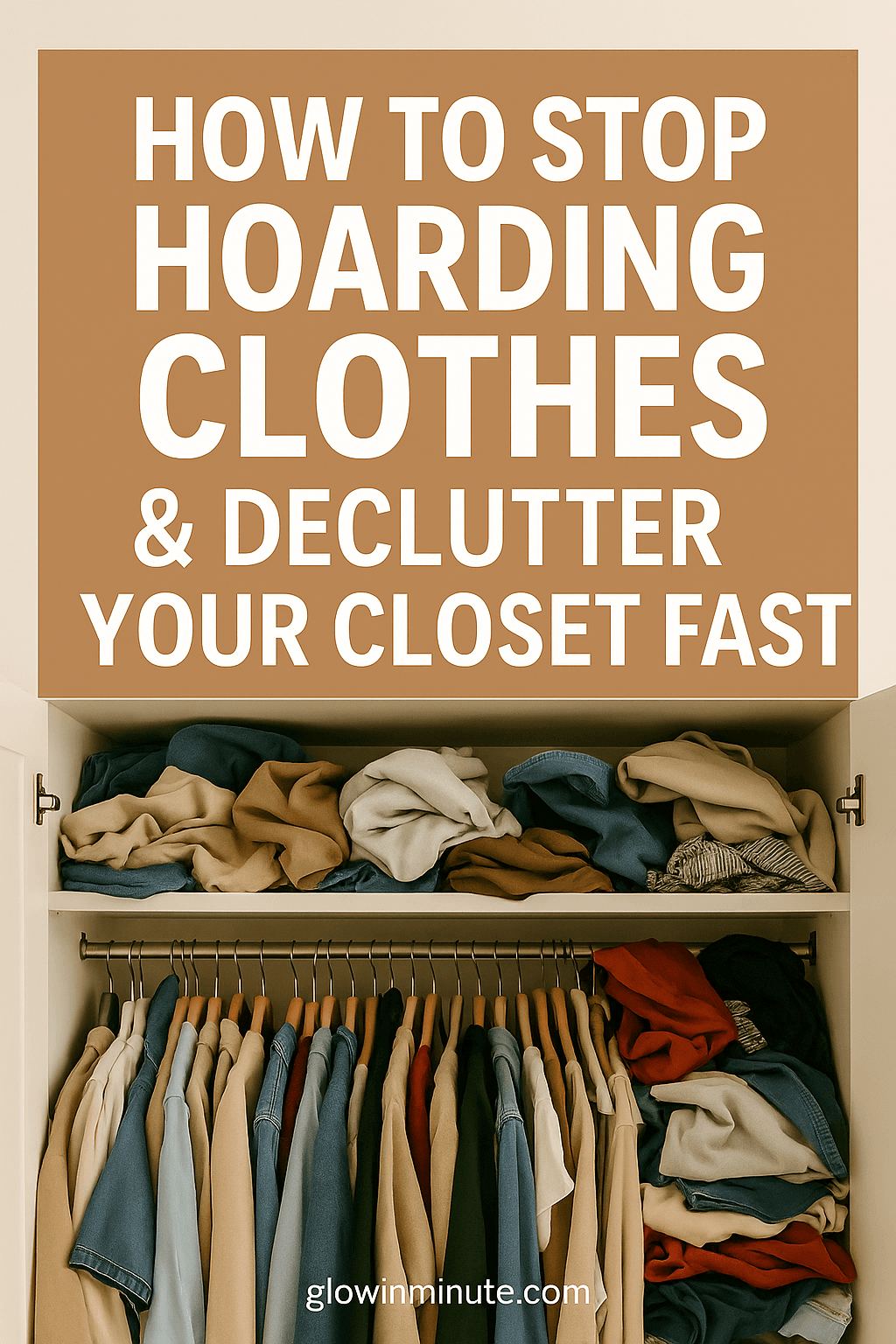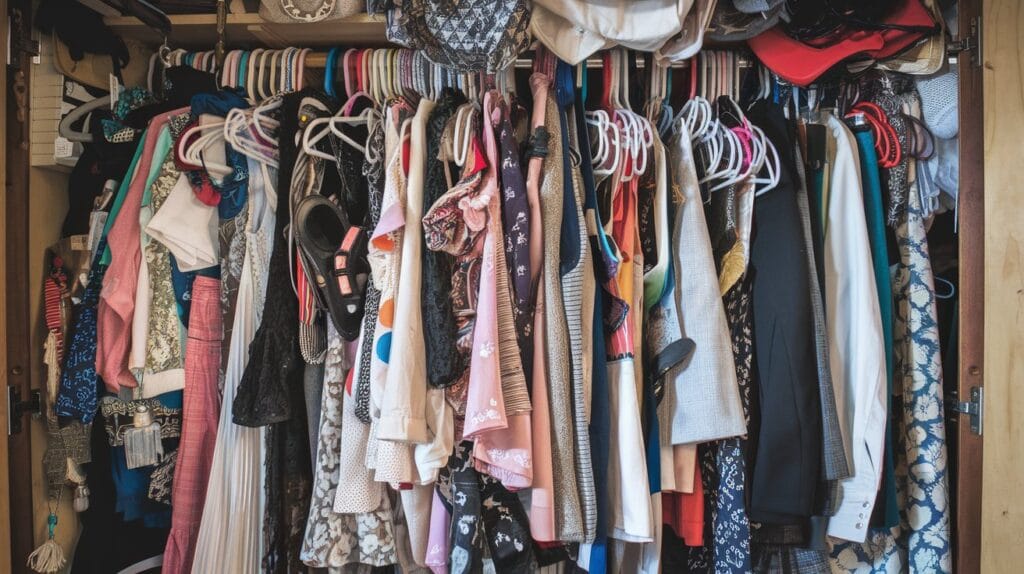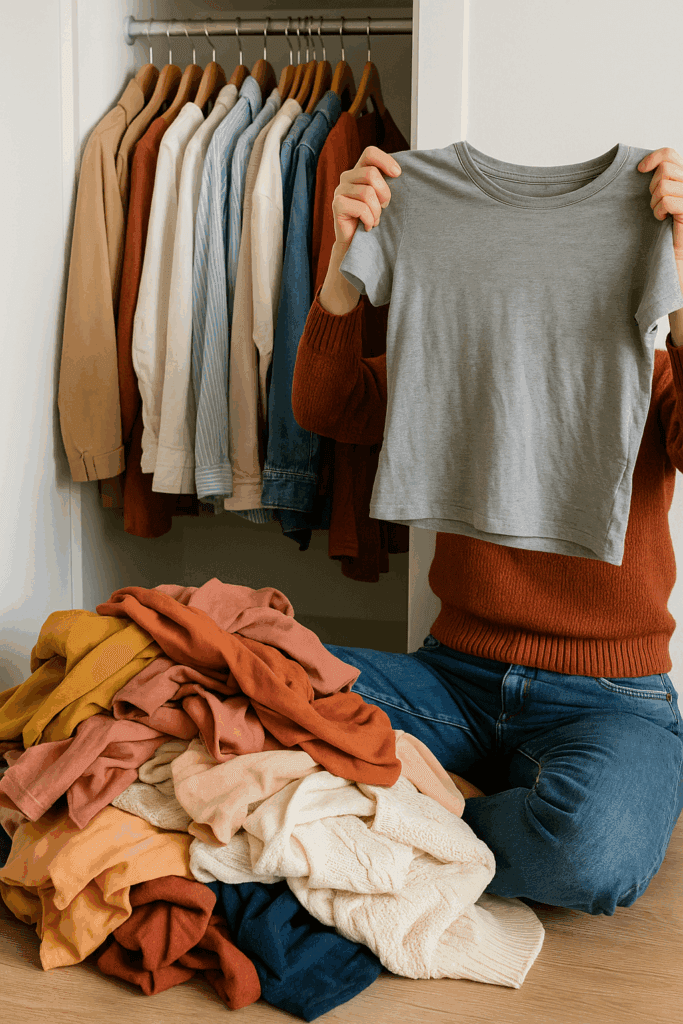Clothes hoarding can quietly take over a person’s wardrobe, turning a once manageable space into a cluttered mess.
Many people hold onto clothes out of emotional attachment or fear they might need them later
The key to stopping clothes hoarding is to create a clear plan that includes decluttering, organizing, and learning to shop more mindfully.

Addressing clothes hoarding means understanding why the clutter builds up and then taking practical steps to manage it.
Using a step-by-step method helps break the habit and makes it easier to keep the wardrobe neat. For those who struggle, following a detailed plan can be a useful way to take control and form better habits.
By focusing on simple strategies to declutter and stay organized, anyone can reduce overload and keep only what truly matters.
Learning how to shop thoughtfully is also part of the process, helping prevent the pileup from happening again.
This approach is explained well in the clear plan to stop hoarding clothes and create a clutter-free wardrobe.

Understanding Clothes Hoarding
Clothes hoarding involves more than just owning many garments. It includes repeated buying, difficulty throwing items away, and emotional attachment to clothes.
This behavior often results from specific causes and can have notable mental effects.
What Constitutes Clothes Hoarding
Clothes hoarding means keeping an excessive number of clothing items, often beyond what is practical. A person may continuously buy clothes even if they have enough or more than they use.
It is marked by difficulty discarding old or unused clothes, which leads to cluttered spaces. Many hoarders wear only a small fraction of their wardrobe regularly, sometimes less than 20%.
The behavior goes beyond simple collecting. It disrupts daily life and organizes challenges, making clothes a source of stress rather than convenience.

Common Causes of Hoarding Clothes
Several factors lead a person to hoard clothes. Emotional attachment plays a big role, as some link clothes to memories or personal identity. They may fear losing those feelings if they get rid of the items.
Fear of waste is another cause. Some believe a piece of clothing might be useful later, which makes throwing it away feel wrong.
Impulse buying and difficulty setting limits on shopping increase clothes accumulation. Social or psychological issues, like anxiety or depression, can worsen the tendency to hoard clothing.
Psychological Impact
Hoarding clothes often causes mental health challenges. Cluttered closets and homes create stress, anxiety, and feelings of being overwhelmed.
It may affect self-esteem, especially if the person notices their hoarding affects their social life or daily routine. The inability to manage clothes leads to frustration and guilt.
Hoarding is linked to deeper psychological issues, such as obsessive-compulsive disorder (OCD) or hoarding disorder, which require professional support for effective treatment.
Recognizing the Signs of Clothes Hoarding
Clothes hoarding shows itself through clear physical clutter, strong emotional ties to items, and certain behaviors that make it hard to let go of clothing.
Spotting these signs can help someone understand when hoarding is a problem.
Identifying Physical Clutter
Physical clutter usually means clothes are piled up in closets, drawers, or even on the floor. The amount of clothing far exceeds what can be neatly stored or worn regularly.
Closets may be stuffed with outdated, unused, or damaged clothes. Access to items becomes difficult, making it hard to find what they need.
This clutter often blocks living spaces, causing frustration and stress.
Signs of physical clutter include:
- Clothes spilling out of storage areas
- Multiple layers of folded or unfolded garments
- Lack of clear organization or space to add new clothes
Emotional Attachment to Clothing
People who hoard clothes often keep items because of strong feelings. These can include memories tied to an event, fear of needing the item later, or even guilt about wasting money.
This emotional bond makes it very hard to throw clothes away, even if they no longer fit or are damaged. Some might keep items to hold on to a past identity or hope they will fit again.
Fear and anxiety about letting go can lead to holding on to clothes indefinitely. This worsens clutter and makes change difficult without support.
Behavioral Patterns
Clothes hoarding is also shown in certain behaviors. A person may avoid sorting through their wardrobe because it feels overwhelming or upsetting.
They might buy new clothes constantly, even when they do not need them. This adds to the problem. Others may hide or move piles of clothes around to avoid dealing with them.
They may also feel shame or embarrassment about their clutter but feel unable to stop the cycle. Recognizing these patterns is key to starting a plan to reduce hoarding.
Preparing to Stop Hoarding Clothes
Stopping clothes hoarding starts with careful planning. It requires clear goals, strong motivation, and handling emotional challenges like guilt and anxiety.
These steps set the foundation for lasting change.
Setting Realistic Goals
Setting clear, achievable goals is essential. Instead of trying to fix everything at once, he or she should break down the process into small tasks.
For example, aim to declutter one drawer or category of clothing each day or week.
Using a checklist or planner can help track progress. Goals might include donating five items per week or sorting through clothes for 15 minutes daily.
This gradual approach makes decluttering manageable and less overwhelming.
It’s important that goals are specific and time-bound. Vague goals like “clean the closet” can feel too big.
Instead, precise goals such as “sort out all shirts by Sunday” provide clear direction and a sense of accomplishment.
Building Motivation
Motivation often comes from understanding why the change is needed. He or she should identify personal reasons for stopping clothes hoarding, such as wanting a neater space or saving money.
Visual reminders like before-and-after photos or a tidy closet image can reinforce the desire to maintain progress. Celebrating small wins, like completing a part of the wardrobe, helps keep momentum.
Creating a reward system also boosts motivation. Rewards could be a small treat after decluttering sessions or spending saved money on something meaningful, not clothes.
Sharing goals with friends or family can add support and accountability.
Overcoming Guilt and Anxiety
Guilt about letting go of clothes is common. He or she may feel worried about wasting money or losing items that could be useful someday.
Recognizing that these feelings are normal helps reduce their power.
Techniques like the “reverse hanger trick” can aid decision-making. Clothes are hung backwards, and after wearing them once, the hanger is flipped forward.
This helps identify which items are truly needed and which can be let go.
It’s also helpful to remind oneself that donating or recycling unwanted clothes benefits others and reduces waste.
If anxiety is strong, focusing on small steps rather than the whole task can prevent feeling overwhelmed.
Taking breaks and practicing calm breathing supports emotional control during the process.
Effective Decluttering Strategies
Stopping clothes hoarding requires clear, practical steps. Sorting clothes, deciding what to keep or let go, and organizing the remaining items help reduce clutter effectively.
Giving away or disposing of unused clothes can free up space and reduce stress.
Sorting Methods for Clothing
One useful way to start is by sorting clothes into groups. He or she might sort by season, type (shirts, pants, coats), or use frequency.
Sorting by season helps in deciding which items to store away or keep accessible.
Trying on clothes during sorting reveals fit and style. Items that are damaged, don’t fit, or that haven’t been worn in a long time should be set aside.
It’s helpful to keep only the clothes that are worn regularly or hold real value.
Some find it easier to focus on one category at a time, like shoes or jackets. This reduces overwhelm and makes the process manageable.
The One-Year Rule
A key rule for deciding what to keep is the one-year rule. If someone hasn’t worn a piece of clothing in the past year, it’s often safe to let it go.
This method helps avoid holding onto items “just in case.”
This rule is practical because it reflects actual use rather than sentimental value. Clothes stored for a whole year without use usually do not fit the person’s current needs or style.
Exceptions may apply for special-occasion clothes. However, if several years have passed without use, donating or discarding is usually best.
Donation and Disposal Options
Giving clothes away benefits both the owner and others. He or she can donate usable clothes to local charities, shelters, or thrift stores. This often helps those in need and reduces environmental waste.
For unsuitable clothes (torn, stained, or very old), disposal options include recycling programs that accept textiles. Some communities offer bins or centers for textile recycling.
Selling clothes online or at consignment shops can also be an option for valuable items. This method can bring money while reducing wardrobe size.
Organizing What You Keep
Once the decision on what to keep is made, organizing those clothes helps maintain order. Using drawers, shelves, or hangers by type and color makes choosing clothes quicker.
Keeping only a manageable number of garments prevents future clutter. A good habit is to replace each new item with a donation or disposal of an old one.
Storing out-of-season clothes in labeled bins or under-bed storage frees closet space. Clear containers help identify contents without digging through piles.
Consistent organizing routines help prevent hoarding tendencies from returning.

Leave a Reply